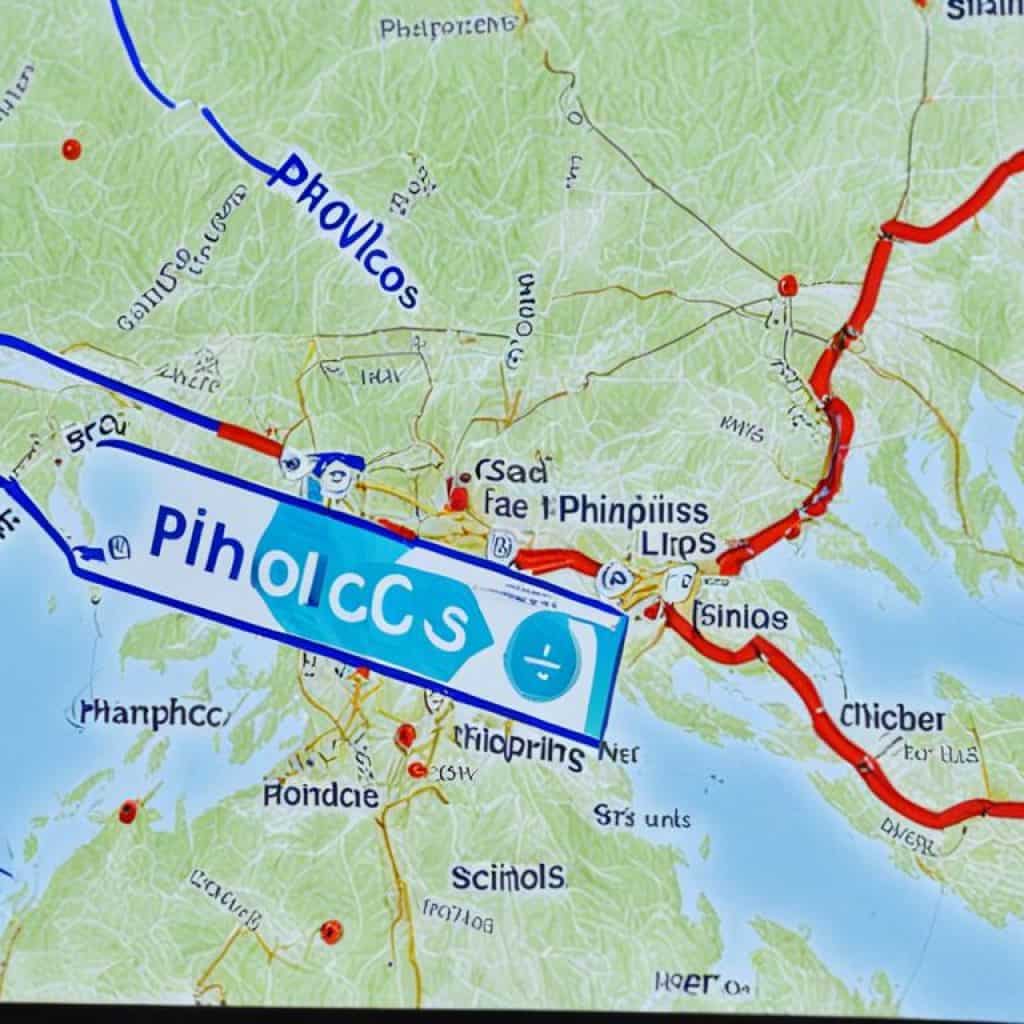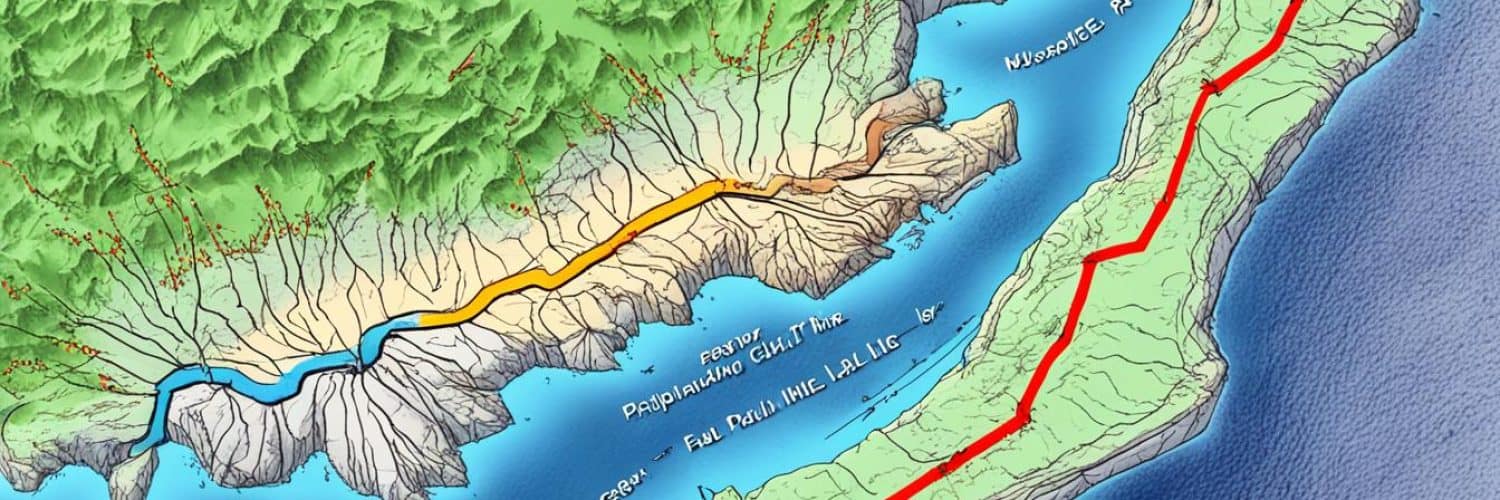Have you ever wondered what makes the Philippines prone to earthquakes? Is there a hidden geological secret lying beneath its surface? Brace yourself as we dive deep into the fascinating world of the Philippines’ fault line.
The Philippines, situated in the Pacific Ring of Fire, experiences high seismic activity due to its location on the Philippine Mobile Belt, a system of geological faults caused by tectonic plate boundary forces. The Philippine Fault System, a vast network of faults spanning the entire archipelago, plays a significant role in shaping the country’s seismic landscape.
Curious to know which areas are most at risk? We’ll explore fault lines such as the Marikina Valley Fault System, the Western and Eastern Philippine Fault Lines, the Southern Mindanao Fault Lines, and the Central Philippine Fault Zone. Get ready to uncover the secrets hidden beneath the surface of the land of islands!
Key Takeaways:
- The Philippines is located in the Pacific Ring of Fire, making it prone to seismic activity.
- The Philippine Fault System is a network of faults that runs throughout the entire archipelago.
- Fault lines like the Marikina Valley Fault System and the Central Philippine Fault Zone pose significant seismic hazards.
- Tools like the PHIVOLCS Fault Finder can help determine the proximity of your location to active fault lines.
- Investing in properties located far from fault lines can ensure earthquake safety and peace of mind.
What is a fault line?
A fault line is a crack in the Earth’s crust where two sides of the fault have moved past each other. When the movement occurs, it generates seismic waves, resulting in an earthquake. Fault lines are responsible for the majority of earthquakes worldwide.
Marikina Valley Fault System
The Marikina Valley Fault System is one of the most hazardous fault lines in the Philippines, with a high potential for seismic activity. Running through densely populated areas, including Manila, this fault line poses a significant risk to the surrounding cities and provinces. It is the most seismically active fault line in the country, making it crucial for residents and authorities to remain vigilant and prepared.
The Marikina Valley Fault System has gained particular attention due to its potential to trigger volcanic activity, such as the eruption of Taal Volcano. The fault line’s proximity to Taal Volcano raises concerns about the possibility of strong earthquakes accompanying volcanic events. As seismic activity along the fault line intensifies, the risk of volcanic eruption also increases.
Residents and local authorities in areas along the Marikina Valley Fault System should prioritize earthquake preparedness measures. Being well-informed about evacuation plans, emergency shelters, and communication protocols is crucial for minimizing the potential impact of seismic events. Community engagement and awareness initiatives can help educate individuals on the importance of readiness.
To better understand the significance of the Marikina Valley Fault System and its potential impact, let’s take a look at some key facts:
Fact: The Marikina Valley Fault System is approximately 120 kilometers long and runs along the eastern part of Metro Manila.
Fact: The fault line has been responsible for past earthquakes, including the destructive 1863 M7 earthquake and the 1880 M6.5 earthquake.
Given the high seismic activity associated with the Marikina Valley Fault System, it is essential for affected communities to remain prepared and take proactive measures to enhance their resilience. Regular drills, maintaining emergency kits, and staying updated on the latest information from local authorities are essential steps in staying safe during potential earthquakes.
Learning from the Marikina Valley Fault System
The Marikina Valley Fault System serves as a reminder of the need for ongoing research, monitoring, and preparedness against seismic hazards. By studying the fault line’s behavior and understanding the potential for triggering volcanic events, scientists and authorities can develop more robust strategies for mitigating risk and safeguarding communities.
Western Philippine Fault Lines
The Western Philippine Fault Lines are a network of underwater fault lines located in the Western region of the Philippines. These fault lines pose a significant threat due to the potential for underwater earthquakes, which can trigger tsunamis in the affected areas.
Areas along the Luzon Sea, Mindoro Strait, Panay Gulf, and Sulu Sea are particularly susceptible to seismic activity from these fault lines. The presence of these underwater fault lines in the Western region of the Philippines calls for heightened awareness and preparedness in these coastal areas.
Understanding the Threat
“The Western Philippine Fault Lines are a reminder of the dynamic nature of our planet. These underwater fault lines have the potential to unleash powerful earthquakes and trigger devastating tsunamis. It is crucial for residents of the affected areas to stay informed and take necessary precautions to ensure their safety.”
Underwater fault lines are a unique geological feature that demands attention and careful planning. The potential for underwater earthquakes, combined with the threat of tsunamis, necessitates proactive measures to minimize the impact of these natural disasters.
Coastal Areas at Risk
The Western Philippine Fault Lines pose a significant risk to coastal areas along the Luzon Sea, Mindoro Strait, Panay Gulf, and Sulu Sea. These regions are vulnerable to the potential effects of underwater earthquakes and subsequent tsunamis.
To better understand the areas at risk, refer to the table below:
| Coastal Areas | Risk Level |
|---|---|
| Luzon Sea | High |
| Mindoro Strait | Moderate |
| Panay Gulf | Moderate |
| Sulu Sea | Low |
Note: The risk levels are based on the proximity to the Western Philippine Fault Lines and the potential impact of underwater earthquakes and tsunamis.

It is essential for residents in these coastal areas to have a clear understanding of the potential risks associated with the Western Philippine Fault Lines. Taking appropriate safety measures, such as developing evacuation plans and being aware of early warning systems, can significantly reduce the impact of these natural hazards.
In the next section, we will explore the Eastern Philippine Fault Lines and their implications for the affected regions. Stay tuned to learn more about the underwater fault lines that contribute to the seismic activity in the Philippine Sea.
Eastern Philippine Fault Lines
The Eastern Philippine Fault Lines, located underwater in the Philippine Sea, contribute significantly to the seismic activity in the eastern part of the country. This area, including the Bicol Region and Eastern Visayas, is particularly susceptible to earthquakes caused by these fault lines. The Philippine Sea, home to these fault lines, serves as a key region for understanding the tectonic activity in this part of the Philippine archipelago.
Seismic Activity in the Eastern Philippines
The Eastern Philippine Fault Lines are an integral part of the complex Philippine fault system that spans the entire archipelago. These underwater fault lines in the Philippine Sea contribute to the occurrence of earthquakes in the eastern regions, affecting both land and marine areas. The tectonic forces at work in this area create potential hazards that require proactive earthquake preparedness measures.
“Understanding the Eastern Philippine Fault Lines is crucial for assessing the seismic vulnerability of the Bicol Region and Eastern Visayas. By recognizing the risks associated with these fault lines, communities can take the necessary steps to enhance their resilience and protect lives and infrastructure.”
Key Features of the Eastern Philippine Fault Lines
| Fault Line | Location | Seismic Activity |
|---|---|---|
| Eastern Deep Fault | Philippine Sea | Moderate to high |
| Pacific Ocean Plate Boundary Fault | Philippine Sea | Significant |
| North Philippine Sea Plate Boundary Fault | Philippine Sea | Variable |
Table: Key Features of the Eastern Philippine Fault Lines. The fault lines in the Philippine Sea contribute to seismic activity in the Bicol Region and Eastern Visayas.
Being aware of the Eastern Philippine Fault Lines and their impact on the region is essential for implementing effective disaster preparedness strategies. Through education, early warning systems, and community resilience efforts, the Philippines can mitigate the risks associated with these fault lines and better protect the lives and livelihoods of its people.
Southern Mindanao Fault Lines
The Southern Mindanao Fault Lines traverse the Celebes Sea and the Moro Gulf, areas known for their geological activity. While the fault line itself may not pose an immediate threat to populated areas, the entire region of Southern Mindanao is at risk of earthquakes.
Provinces and cities situated near the Southern Mindanao Fault Lines should prioritize earthquake preparedness and be vigilant in their safety measures. Being prepared can make a significant difference in minimizing the impact of seismic events.
Stay informed about seismic activities and stay updated on evacuation procedures and safety guidelines provided by local authorities. By taking proactive measures, you can help protect your community and ensure the well-being of its residents.

Key Points:
- The Southern Mindanao Fault Lines are located across the Celebes Sea and the Moro Gulf.
- The fault lines in Southern Mindanao pose a risk of earthquakes to the entire region.
- Provinces and cities near the fault lines should prioritize earthquake preparedness.
- Stay informed about seismic activities and follow safety guidelines provided by local authorities.
Being prepared is essential in minimizing the impact of seismic events and ensuring the safety of residents in Southern Mindanao.
Central Philippine Fault Zone
The Central Philippine Fault Zone is a significant fault line in the Philippines known for fault creep, slow slide occurrences, and major earthquakes. This fault line extends from the northern part of the archipelago to the northern part of Davao, spanning a considerable distance. It has been associated with significant seismic events in the past, including the devastating 1990 Baguio earthquake.
Provinces and cities situated along the Central Philippine Fault Zone should be aware of the potential seismic hazards posed by this fault line. Fault creep, the gradual movement that occurs along the fault, can lead to stress buildup and result in sudden, large earthquakes.
To better understand the activity and impact of the Central Philippine Fault Zone, let’s take a look at some key details:
Central Philippine Fault Zone
| Fault Line | Location | Seismic Activity |
|---|---|---|
| Central Philippine Fault Zone | From northern part of the archipelago to the northern part of Davao | Responsible for major earthquakes |
By understanding the characteristics and potential risks associated with the Central Philippine Fault Zone, communities can take proactive measures to ensure safety and preparedness in the event of a significant earthquake.
Remember, being knowledgeable about fault lines and their effects is essential for earthquake preparedness. Stay informed and take necessary precautions to protect yourself and your community.
Discover if your area is close to a fault line via PHIVOLCS Fault Finder
When it comes to earthquake preparedness, knowing whether your area is near an active fault line is crucial. The Philippine Institute of Volcanology and Seismology (PHIVOLCS) understands the importance of this information and has developed a user-friendly online application called the PHIVOLCS Fault Finder.
The PHIVOLCS Fault Finder is an invaluable tool that allows users to determine the proximity of their location to nearby fault lines. By simply inputting your location into the application, it provides accurate information regarding fault line proximity, enabling you to make informed decisions and take appropriate measures for earthquake preparedness.

Using this tool, you can assess whether your area is at risk and understand the potential seismic hazards associated with living in close proximity to a fault line. The PHIVOLCS Fault Finder empowers individuals, communities, and organizations to take proactive steps in implementing safety measures and developing emergency response plans.
“Knowledge is power. By using the PHIVOLCS Fault Finder, you gain valuable insights about your area’s fault line proximity, enabling you to prioritize earthquake preparedness and protect yourself, your loved ones, and your property.” – (Anonymous)
Stay ahead of potential seismic threats by utilizing the PHIVOLCS Fault Finder. With this tool at your disposal, you can make informed decisions and ensure the safety of your community, reinforcing the importance of earthquake preparedness in the Philippines.
Benefits of using the PHIVOLCS Fault Finder:
- Accurate and up-to-date information regarding fault line proximity
- Enhanced understanding of potential seismic hazards in your area
- Improved earthquake preparedness and safety measures
- Simplified development of emergency response plans
- Empowerment to make informed decisions regarding housing and infrastructure
- Contribution to community resilience and disaster risk reduction efforts
How to access the PHIVOLCS Fault Finder:
- Visit the PHIVOLCS website at www.phivolcs.gov.ph
- Navigate to the FaultFinder section
- Enter your location details
- View the fault line proximity and relevant information
Take advantage of the PHIVOLCS Fault Finder today and empower yourself with knowledge about fault line proximity. By staying informed and proactive, you can play a vital role in safeguarding your community and minimizing the risks associated with earthquakes.
Invest in a house and lot far from fault lines
When searching for a house and lot property in the Philippines, it is essential to prioritize the safety of your investment. Considering the proximity to fault lines is a crucial factor in earthquake preparedness. Investing in a property that is far from fault lines can provide you with a sense of security and peace of mind for you and your family.
Lumina Homes, a trusted real estate developer in the Philippines, offers housing projects in various locations that are situated far from fault lines. With a commitment to providing safe and affordable homes, Lumina Homes ensures that its properties are built in areas where fault line safety is prioritized. By choosing a house and lot from Lumina Homes, you can invest in a property that combines comfort, affordability, and most importantly, seismic stability.
Don’t compromise on the safety of your dream home! Take advantage of Lumina Homes’ offerings and secure a house and lot far from fault lines, so you can confidently build a future with peace of mind.
Conclusion
Ensuring fault line safety and earthquake preparedness is crucial in a country like the Philippines, which is prone to seismic activity due to its Philippine fault system. By understanding the active fault lines and their proximity to populated areas, individuals can take proactive measures to protect themselves and their properties. Utilizing tools like the PHIVOLCS Fault Finder can provide valuable information to stay informed and prepared. Choosing safe locations for housing investments, such as those offered by Lumina Homes, far from fault lines can provide a sense of security. Remember, staying informed and proactive is key to earthquake safety.
Key Takeaways:
- Understand the active fault lines in the Philippines and their proximity to populated areas.
- Utilize tools like the PHIVOLCS Fault Finder for valuable information on fault line proximity.
- Choose safe locations for housing investments, far from fault lines.
- Stay informed and proactive in earthquake safety measures.
Comparison of Fault Lines in the Philippines
| Fault Line | Location | Main Threats |
|---|---|---|
| Marikina Valley Fault System | Marikina Valley and Manila | Potential for strong earthquakes and volcanic activity |
| Western Philippine Fault Lines | Underwater in the Western region | Underwater earthquakes and tsunamis |
| Eastern Philippine Fault Lines | Underwater in the Philippine Sea | Eastern part of the country vulnerable to earthquakes |
| Southern Mindanao Fault Lines | Celebes Sea and Moro Gulf | Southern Mindanao at risk of earthquakes |
| Central Philippine Fault Zone | Northern part of the archipelago to the northern part of Davao | Fault creep, large earthquakes, and associated seismic hazards |
Philippine Fault Zone
The Philippine Fault Zone is a major fault system in the country that stretches across the archipelago. It consists of multiple fault segments, including the Guinayangan, Masbate, and Central Leyte faults. These fault segments are known for their seismic activity and have the potential to generate large earthquakes. Areas traversed by the Philippine Fault Zone should be prepared for possible seismic events.
Fault Segments in the Philippine Fault Zone
| Fault Segment | Location |
|---|---|
| Guinayangan Fault | Quezon Province |
| Masbate Fault | Masbate Province |
| Central Leyte Fault | Leyte Province |
The Philippine Fault Zone is an active fault system that poses a significant seismic risk to the regions it traverses. It is essential for these areas to be prepared for potential earthquakes and have proper earthquake-resistant infrastructure in place.
In the event of an earthquake, it is crucial to follow safety protocols and be aware of evacuation routes. Stay informed through reliable sources, such as the Philippine Institute of Volcanology and Seismology (PHIVOLCS), and be prepared to take appropriate action to ensure the safety of yourself and your loved ones.
By understanding and acknowledging the presence of the Philippine Fault Zone, communities can take proactive measures to mitigate the risks associated with seismic activity and create a safer environment for all.
Other active fault systems
Aside from the major fault lines mentioned earlier, the Philippines is also home to several other active fault systems that contribute to the country’s overall seismic activity. These fault systems should be taken into account for earthquake preparedness.
Valley Fault System
The Valley Fault System is a significant fault line that runs through the Greater Manila Area. It is composed of two segments: the East Valley Fault and the West Valley Fault. This fault system poses a significant seismic hazard to highly populated areas such as Metro Manila and surrounding provinces.
Macolod Corridor
The Macolod Corridor is a fault system located in central Luzon, specifically in the provinces of Pampanga and Tarlac. It runs parallel to the Macolod River and poses earthquake hazards to nearby communities.
Lubang-Verde Passage Fault System
The Lubang-Verde Passage Fault System consists of multiple fault segments located in the Verde Island Passage in Batangas and Mindoro. This fault system is known for its seismic activity and can potentially generate strong earthquakes in the region.
Mindoro/Aglubang Fault
The Mindoro/Aglubang Fault is a fault system situated in Mindoro and Batangas. This fault system is associated with seismic activity in the region and poses a potential earthquake hazard to nearby areas.
Sibuyan Sea Fault
The Sibuyan Sea Fault is an underwater fault system located in the Sibuyan Sea, east of Luzon. It is associated with seismic activity in the region, contributing to the overall seismic hazards in the Philippines.
Legaspi Lineament
The Legaspi Lineament is a fault system that runs along the eastern coast of Luzon, specifically in the Bicol Region. It is associated with tectonic activity and contributes to the seismic hazards in the area.
Tablas Lineament
The Tablas Lineament is a fault system located in Romblon and Marinduque. It runs along the Tablas Strait and contributes to the overall seismic activity in the vicinity.
Mindanao Fault
The Mindanao Fault is a complex fault system spanning the entire Mindanao island. It consists of several fault segments and is associated with significant seismic activity in the region, making it prone to earthquakes.
Offshore Cebu-Bohol Faults
The Offshore Cebu-Bohol Faults are underwater fault systems located off the coasts of Cebu and Bohol. These fault systems contribute to the seismic hazards in the Visayas region.
Understanding the presence and characteristics of these active fault systems is crucial for earthquake preparedness and ensuring the safety of communities residing in these areas.
| Fault System | Location |
|---|---|
| Valley Fault System | Greater Manila Area |
| Macolod Corridor | Pampanga and Tarlac |
| Lubang-Verde Passage Fault System | Batangas and Mindoro |
| Mindoro/Aglubang Fault | Mindoro and Batangas |
| Sibuyan Sea Fault | Sibuyan Sea |
| Legaspi Lineament | Bicol Region |
| Tablas Lineament | Romblon and Marinduque |
| Mindanao Fault | Mindanao Island |
| Offshore Cebu-Bohol Faults | Cebu and Bohol |
What is a fault line?
A fault line, also known as a fault, is a crack in the Earth’s crust where two blocks of rock have moved in relation to each other. When the movement occurs, it releases energy in the form of seismic waves, resulting in an earthquake.
Fault lines are essential in understanding the occurrence and behavior of earthquakes. By studying fault lines, scientists can gain insight into the forces that shape the Earth’s crust and the patterns of seismic activity. This knowledge plays a crucial role in earthquake prediction, preparedness, and mitigation efforts.
Seismic waves generated by fault line movements can cause significant damage to structures and pose a threat to human lives. Understanding fault line characteristics, such as the magnitude and direction of movement, can help engineers and city planners design structures that can withstand earthquakes. It also allows communities to develop appropriate emergency response plans to minimize the impact of seismic events.
Conclusion
Understanding the fault lines in the Philippines is essential for ensuring fault line safety and earthquake preparedness. The country’s location in the Pacific Ring of Fire makes it susceptible to seismic activity, and the presence of active fault systems, such as the Philippine Fault System, further increases the risk.
By staying informed about the geological fault zones and seismic hazards in their area, individuals can take proactive measures to protect themselves and their communities. Utilizing tools like the PHIVOLCS Fault Finder can provide valuable information on fault line proximity and help prioritize earthquake safety measures.
Investing in houses and lots far from fault lines, such as those offered by Lumina Homes, can provide added peace of mind. Being prepared for earthquakes through proper planning, emergency kits, and evacuation plans is crucial for minimizing the potential impact of seismic events.
Ultimately, by prioritizing fault line safety and earthquake preparedness, individuals can safeguard their lives and properties in the face of the Philippine fault system’s ongoing seismic activity.


















Add comment